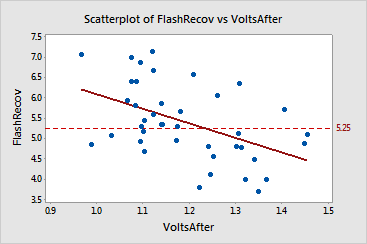main topics interpreting results session command see also
You are interested in how well your company's camera batteries are meeting customers' needs. Market research shows that customers become annoyed if they have to wait longer than 5.25 seconds between flashes.
You collect a sample of batteries that have been in use for varying amounts of time and measure the voltage remaining in each battery immediately after a flash (VoltsAfter), as well as the length of time required for the battery to be able to flash again (flash recovery time, FlashRecov). Create a scatterplot to examine the results. Include a regression line, as well as a reference line at the critical flash recovery time of 5.25 seconds.
1 Open the worksheet BATTERIES.MTW.
2 Choose Graph > Scatterplot.
3 Choose With Regression, then click OK.
4 Under Y variables, enter FlashRecov. Under X variables, enter VoltsAfter.
5 Click Scale, then click the Reference Lines tab.
6 In Show reference lines at Y values, type 5.25. Click OK in each dialog box.
Graph window output

As expected, lower voltages after a flash are associated with longer flash recovery times. The regression line suggests that, in general, voltages lower than about 1.23 are associated with recovery times greater than 5.25, though there is obviously a lot of variability.
|
Tip |
To see the regression equation, hover your cursor over the line. |